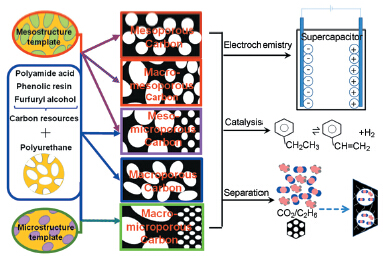| [1] Wan Y, Shi Y F, Zhao D Y. Chem. Mater., 2008, 20: 932.
[2] 邢宝林(Xing B L), 张传祥(Zhang C X), 沈卫卫(Shen W W), 韩怀远(Han H Y). 化学与生物工程(Chemistry & Bioengineering), 2007, 24(9): 27.
[3] Gibson L J(美), Ashby M F(英)著, 刘培生(Liu P S)(译). 多孔固体结构与性能(第二版)(Cellular Solids: Structure and Properties).2ed. 北京: 清华大学出版社(Beijing: Tsinghua University Press), 2003.
[4] Huang Y, Cai H Q, Feng D, Gu D, Deng Y H, Tu B, Wang H T, Webley P A, Zhao D Y. Chem. Commun., 2008, 2641.
[5] Kim Y S, Guo X F, Kim G J. Catal. Today, 2010, 150: 91.
[6] Deng Y H, Liu C, Liu J, Zhang F, Yu T, Zhang F Q, Gu D, Zhao D. J. Mater. Chem., 2008, 18: 408.
[7] 李沛勇(Li P Y), 戴圣龙(Dai S L), 柴世昌(Chai S C), 李裕仁(Li Y R). 材料工程(Journal of Materials Engineering), 2000, (1): 38.
[8] Xue C, Wang J, Tu B, Zhao D. Chem. Mater., 2010, 22: 494.
[9] Yue M B, Sun M N, Xie F, Ren D D. Micropor. Mesopor. Mat., 2014, 183: 177.
[10] Luyten J, Thijs I, Vandermeulen W, Mullens S, Wallaeys B, Mortelmans R. Adv. Appl. Ceram., 2005, 104: 4.
[11] Colombo P. Philos. T. R. Soc. A, 2006, 364: 109.
[12] 蒲锡鹏(Pu X P), 张大风(Zhang D F), 贾丽萍(Jia L P). 材料导报(Materials Review), 2007, 21(z1): 241.
[13] 王艳香(Wang Y X), 孙健(Sun J), 陈文兵(Chen W B), 余熙(Yu X). 硅酸盐学报(Journal of the Chinese Ceramic Society), 2008, 36(S1): 108.
[14] Quintero M W, Escobar J A, Rey A, Sarmiento A, Rambo C R, Oliveira A P N, Hotza D. J. Mater. Process. Technol., 2009, 209: 5313.
[15] 徐飞(Xu F), 吉晓莉(Ji X L). 材料导报(Materials Review), 2009, 23: 473.
[16] 黎阳(Li Y), 陈璐(Chen L), 刘卫(Liu W). 中国陶瓷(China Ceramics), 2011, 47(10): 25.
[17] Reinhardt B, Herwig J, Rannabauer S, Scheffler M, Enke D. J. Eur. Ceram. Soc., 2014, 34: 1465.
[18] 王阳(Wang Y), 金磊(Jin L), 史小蕾(Shi X L), 孟祥康(Meng X K). 医学研究生学报(Journal of Medical Postgraduates), 2012, 25(6): 635.
[19] 李敏(Li M), 张厚安(Zhang H A), 谭香玲(Tan X L), 聂小武(Nie X W). 矿冶工程(Mining and Metallurgical Engineering), 2012, 32(4): 106.
[20] Nikom J, Charoonpatrapong-Panyayong K, Kedjarune-Leggat U, Stevens R, Kosachan N, Jaroenworaluck A. J. Biomed. Mater. Res. A, 2013, 101: 2295.
[21] Tram N X T, Maruta M, Tsuru K, Matsuya S, Ishikawa K. Advances in Bioceramics and Porous Ceramics VI.Eds Narayan R, Colombo P, Kirihara S, Widjaja S. Hoboken: John Wiley & Sons, 2013.
[22] Thanh T N X, Maruta M, Tsuru K, Matsuya S, Ishikawa K. Advanced Materials Research. Eds. Clark G, Wang C H. Melbourne: Trans Tech Publications, 2014. 1559.
[23] 刘冶球(Liu Y Q), 周杨(Zhou Y), 陈曙光(Chen S G), 银锐明(Yin R M). 中南大学学报(自然科学版)(Journal of Central South University: Science and Technology), 2009, 40(5): 1259.
[24] 周杨(Zhou Y). 长沙理工大学硕士论文(Master Dissertation of Changsha University of Science & Technology), 2010.
[25] 龚陶然(Gong T R), 刘其城(Liu Q C), 李海斌(Li H B). 长沙理工大学学报(自然科学版)(Journal of Changsha University of Science and Technology:Natural Science), 2010, 7(4): 82.
[26] Quadbeck P, Stephani G, Kummel K, Adler J, Standke G. Mater. Sci. Forum, 2007, 534/536: 1005.
[27] 吴成(Wu C), 乔冠军(Qiao G J), 王红洁(Wang H J), 金志浩(Jin Z H). 稀有金属材料与工程(Rare Metal Materials and Engineering), 2009, 38(4): 722.
[28] Orefice R L, Ayres E, Pereira M M, Mansur H S. Macromolecules, 2005, 38: 4058.
[29] Das B, Chattopadhyay P, Mishra D, Maiti T K, Maji S, Narayan R, Karak N. J. Mater. Chem. B, 2013, 1: 4115.
[30] Ling Z, Wan P, Yu C, Xiao N, Yang J, Long Y, Qiu J. Chem. Eng. J., 2015, 259: 894.
[31] Liang J, Zhao Z, Hu H, Qiu J. Applied Mechanics and Materials.Eds. Zheng L, Skuroda S, Liu H, Du B, Wei J, Zhao Y. Dalian: Trans Tech Publications, 2013. 130.
[32] 胡守亮(Hu S L).哈尔滨工业大学硕士论文(Master Dissertation of Harbin Institute of Technology), 2010.
[33] Xiao N, Zhou Y, Ling Z, Qiu J. Carbon, 2013, 59: 530.
[34] 肖正浩(Xiao Z H). 大连理工大学硕士论文(Master Dissertation of Dalian University of Technology), 2008.
[35] Xiao N, Zhou Y, Ling Z, Zhao Z, Qiu J. Carbon, 2013, 60: 514.
[36] Inagaki M, Morishita T, Kuno A, Kito T, Hirano M, Suwa T, Kusakawa K. Carbon, 2004, 42: 497.
[37] 胡拥军(Hu Y J), 陈亚(Chen Y). 中南大学学报(自然科学版)(Journal of Central South University:Science and Technology), 2012, 43(7): 2495.
[38] Chen Y, Chen B Z, Shi X C, Xu H, Hu Y J, Yuan Y, Shen N B. Carbon, 2007, 45: 2132.
[39] Nam G, Choi S, Byun H, Rhym Y M, Shim S E. Macromolecules, 2013, 21: 958.
[40] Lu Q, Gao F, Komarneni S, Mallouk T E. J. Am. Chem. Soc., 2004, 126: 8650.
[41] 纪立军(Ji L J), 叶超(Ye C), 梁吉(Liang J). 无机化学学报(Chinese Journal of Inorganic Chemistry), 2007, 23(12): 2007.
[42] 肖南(Xiao N), 凌铮(Ling Z), 王六平(Wang L P), 周颖(Zhou Y), 邱介山(Qiu J S). 第22 届炭-石墨材料学术会议论文集(Proceedings of 22nd Carbon-Graphite Materials Conference), 2010, 159.
[43] 王志超(Wang Z C).大连理工大学硕士论文(Master Dissertation of Dalian University of Technology), 2010.
[44] Wang J, Xue C, Lv Y, Zhang F, Tu B, Zhao D. Carbon, 2011, 49: 4580.
[45] Xue C, Tu B, Zhao D. Nano Res., 2009, 2: 242.
[46] Xue C, Fan J, Hao X. Adv. Porous Mater., 2013, 1: 294.
[47] Xue C, Tu B, Zhao D. Adv. Funct. Mater., 2008, 18: 3914.
[48] 白光晋(Bai G J). 中国特种设备安全(China Special Equipment Safety), 2007, 23(11): 62.
[49] 郭巧梅(Guo Q M). 太原理工大学硕士论文(Master Dissertation of Taiyuan University of Technology), 2009.
[50] Saini V K, Pinto M L, Pires J. Mater. Chem. Phys., 2013, 138: 877.
[51] 肖南(Xiao N).大连理工大学博士论文(Doctoral Dissertation of Dalian University of Technology), 2011.
[52] Wang J, Xue C, Wu Z, Li W, Lv Y, Asiri A M, Tu B, Zhao D. Carbon, 2012, 50: 2546.
[53] 王焕磊(Wang H L), 高秋明(Gao Q M). 高等学校化学学报(Chemical Journal of Chinese Universities), 2011, 32(3): 462. |
